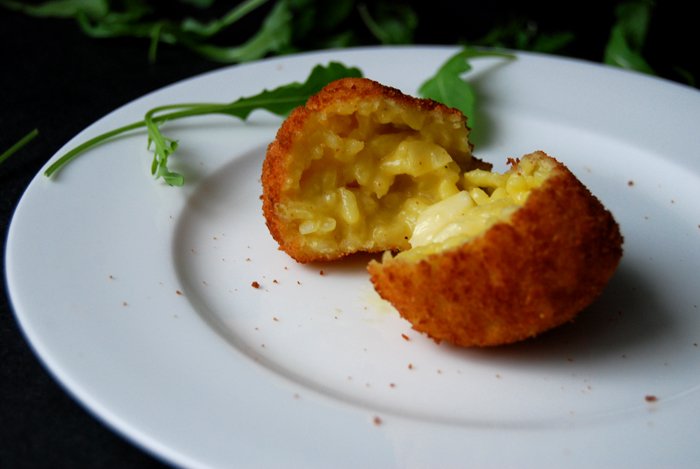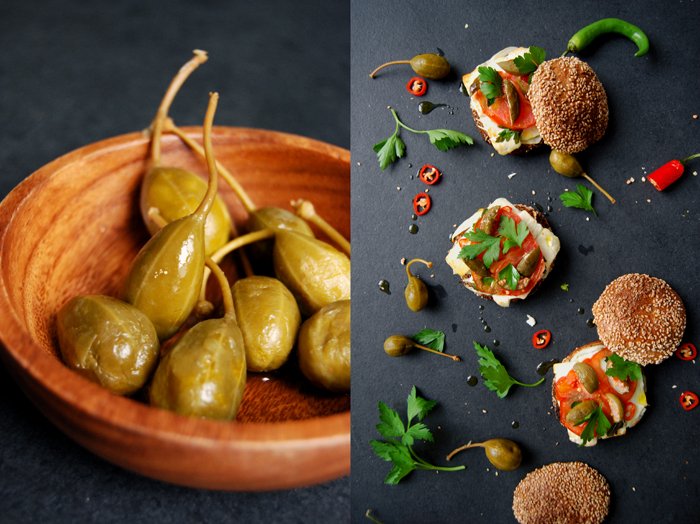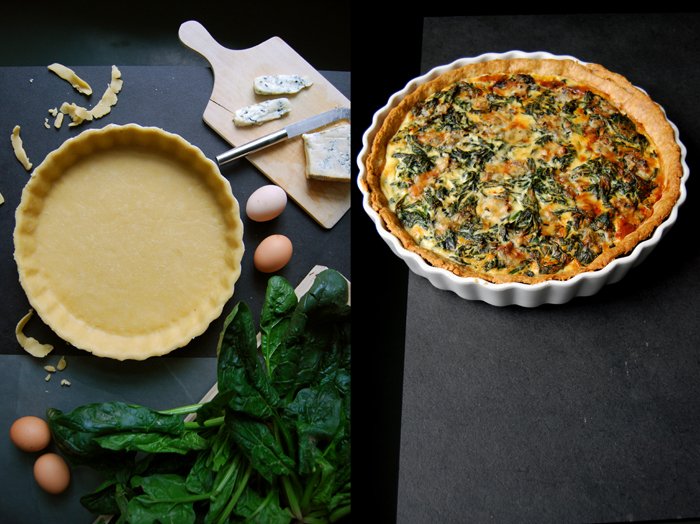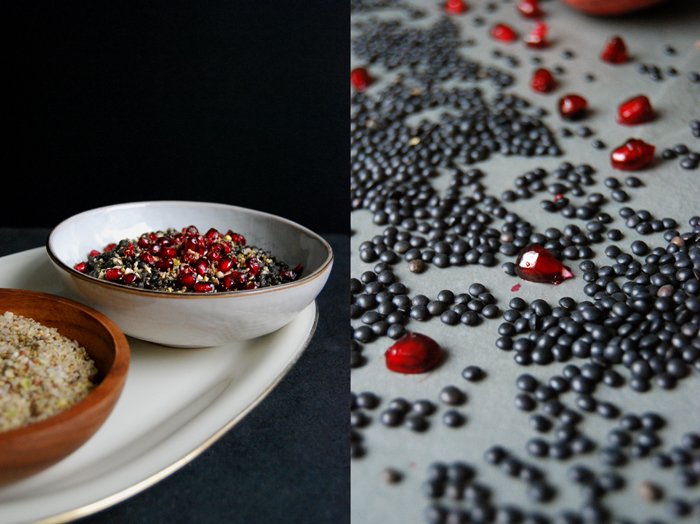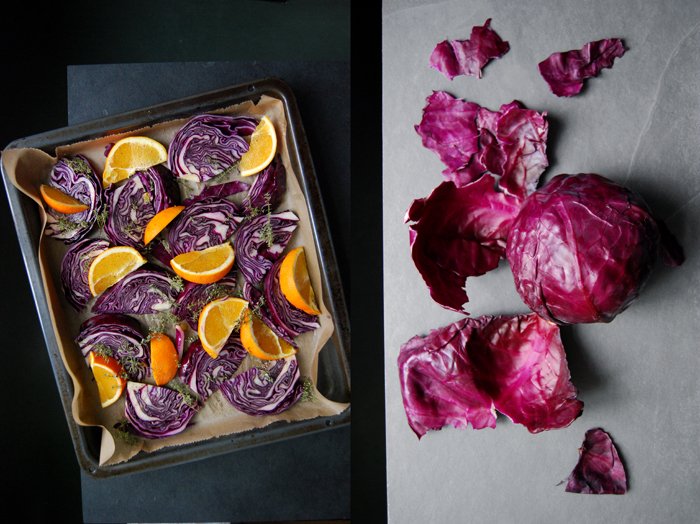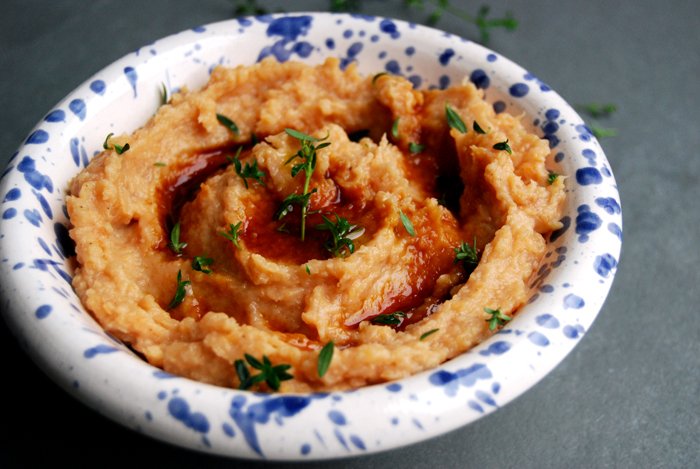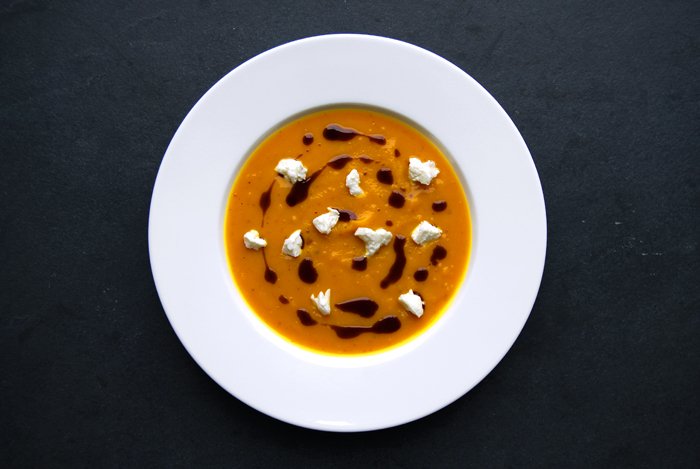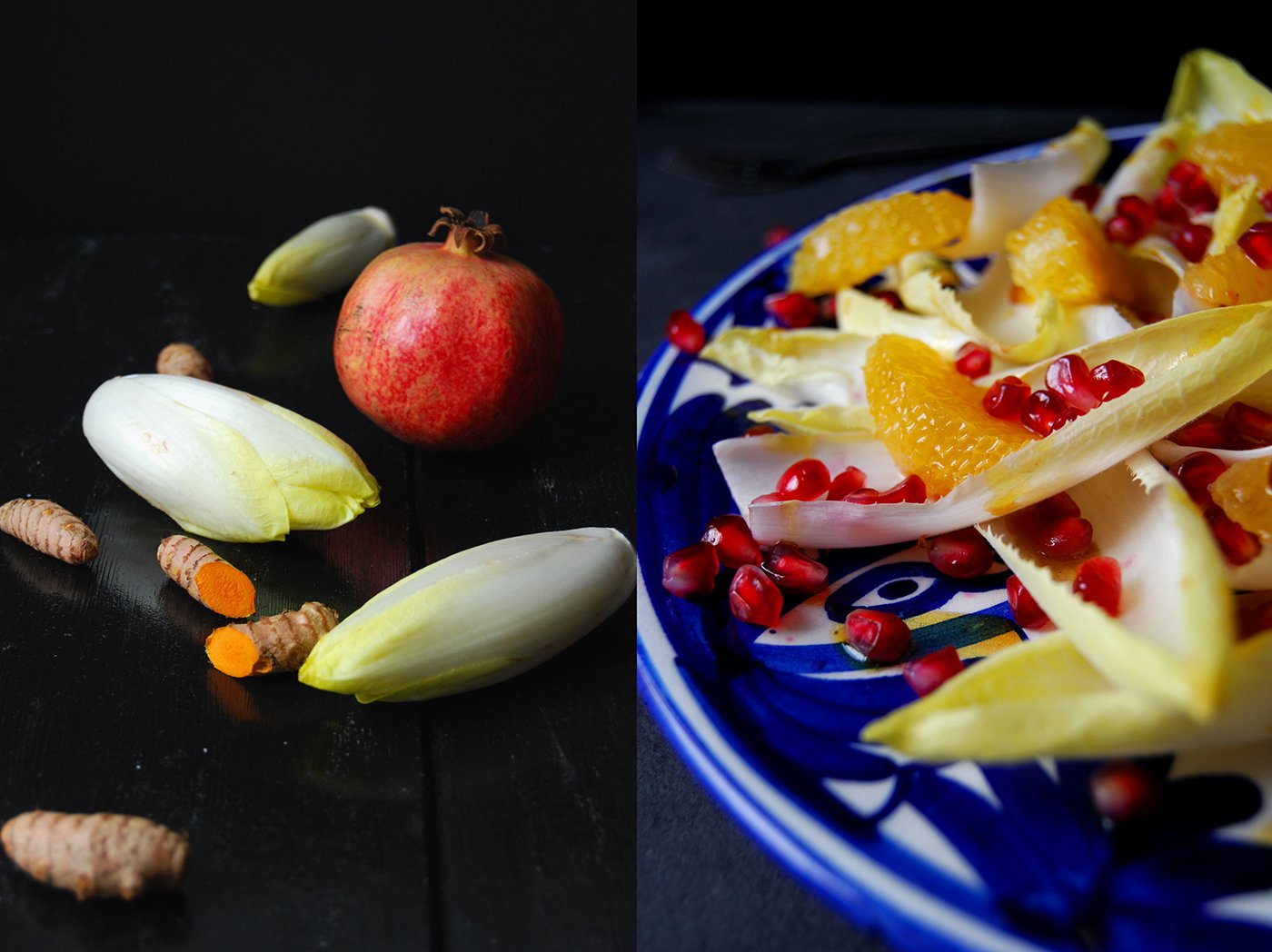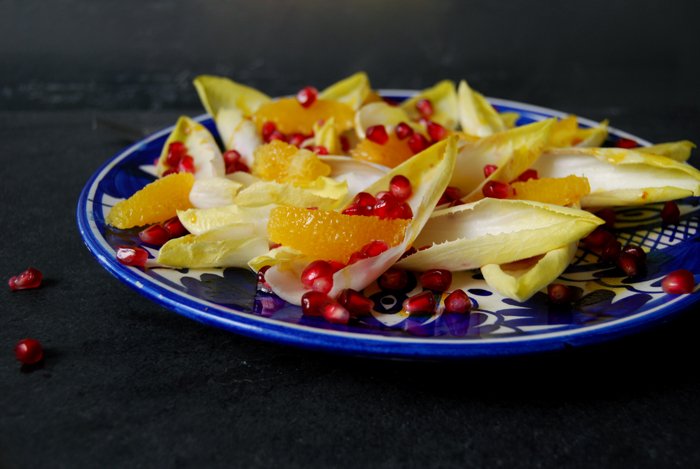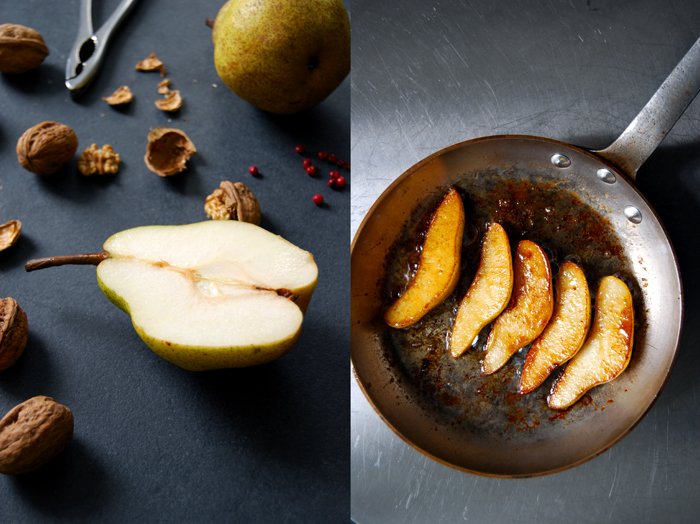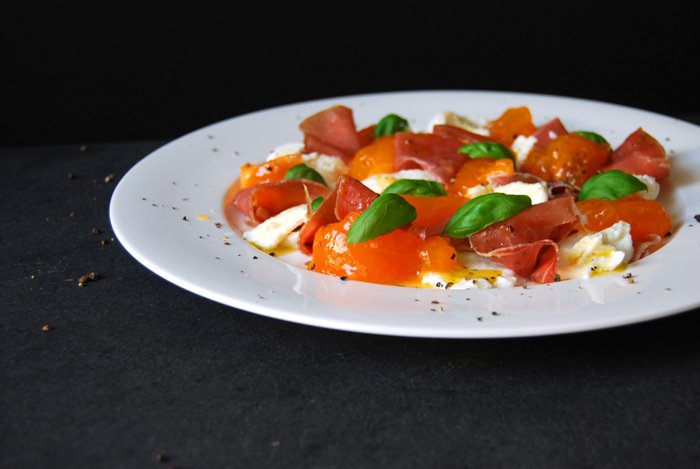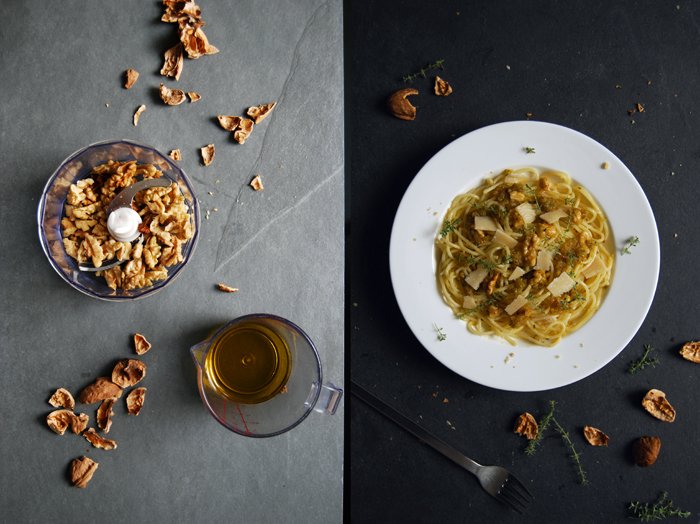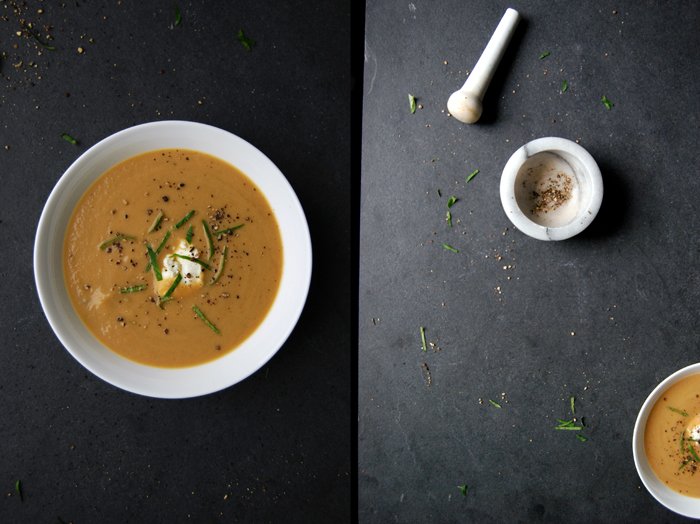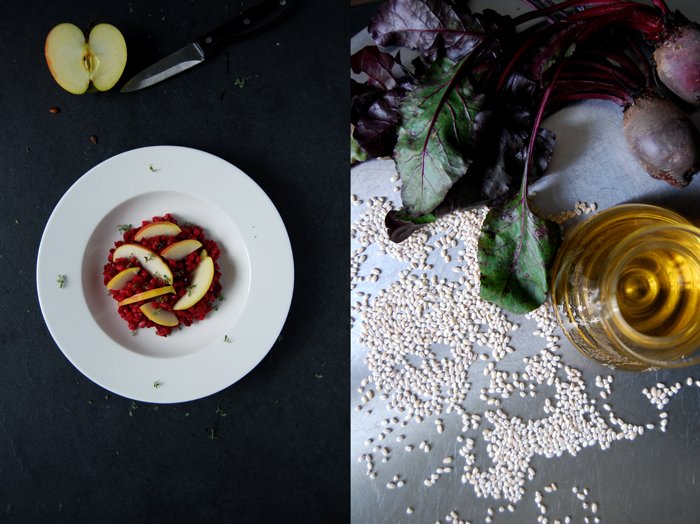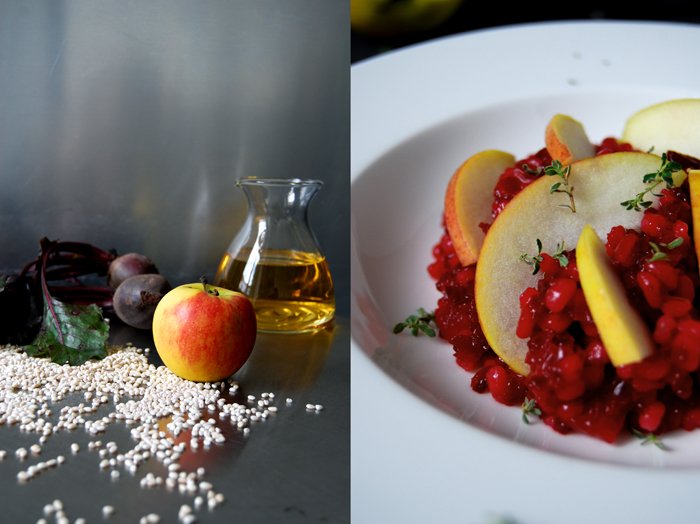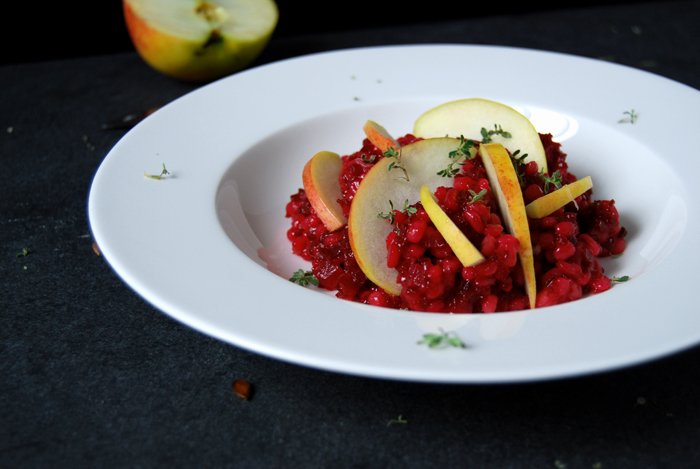Ginger Lemon Ricotta stuffed Cabbage Rolls
The idea for this quick lunch started with leftover ricotta in the fridge and lots of ginger roots, tons of lemons and a lonely cabbage on the kitchen counter. Sometimes these days bring out the best recipes!
A while ago I heard about a traditional Maltese recipe which uses ricotta and raisins to stuff white cabbage leaves. The raisins didn't strike me as much, although I want to try it one day, but the ricotta caught my attention. I mixed it with some eggs, parmesan and lemon zest like I did for my Moussaka in May and I also added plenty of tangy ginger, that gave the whole dish an Asian inspired touch. The large leaves were blanched for just a few minutes, the filling was whipped together even quicker and off it went into the oven. My rolls turned out more like packages, I just lack the skill and patience, but that didn't do them any harm. I served them with fresh lemon butter and even more zest, cheese and ginger on top. We were more than impressed!
Ginger Lemon Ricotta stuffed Cabbage Rolls
For 2 as a main or 4 as a side dish you need
large white / green cabbage leaves 8
ricotta 200g / 7 ounces
organic eggs 2
freshly grated Parmesan 20g / 1 ounce, plus more for the topping
lemon zest 1 teaspoon, plus more for the topping
fresh ginger, grated, 2 teaspoons, plus more for the topping
salt
black peppercorns, crushed in a mortar
white wine to cook the cabbage rolls
For the lemon butter
butter 50g / 2 ounces
freshly squeezed lemon juice 1 tablespoon
Set the oven to 200°C / 390°F (fan-assisted oven).
Heat the butter in a sauce pan with the lemon juice.
Whisk the ricotta, eggs, Parmesan, zest, ginger, salt and pepper and season to taste.
Blanch the cabbage leaves in lots of salted water for about 4-6 minutes or until soft. Rinse them under cold water, drain them and cut out the hard stalk. Dry them with a kitchen paper and lay them flat on the kitchen counter. Put a tablespoon of the ricotta filling in the middle of the cabbage leaves, fold up both sides and roll it up.
Gently place the cabbage rolls in a baking dish and cover the bottom with a splash of white wine and some water. You might have to add some more water while the rolls are cooking. Cook in the hot oven for about 25 minutes or until golden and the filling is set. Serve with the lemon butter and some more Parmesan, zest, ginger and pepper.
Arancine - Sicilian Rice Balls with Saffron and Mozzarella
If you're still looking for a festive vegetarian dish for your Christmas table I can only recommend these little golden balls of rice refined with saffron and stuffed with melted mozzarella, the famous Sicilian arancine! Imagine a bright yellow risotto alla milanese cooked with aromatic saffron in a strong both, mixed with egg yolk and parmesan and shaped into little dumplings. The balls are stuffed with mozzarella and fried with a coating of flour, egg and breadcrumbs until golden brown (which is done in less than a minute). The result looks like tiny oranges which gave them their name arancini or arancine in Sicily, derived from the Italian word for orange, arancia.
Sometimes they are also filled with mushrooms, pistachios or aubergine, or with a meaty tomato sauce, a rich ragù, like in Malta where I love to eat them for lunch at my local confectionary, Busy Bee. The old fashioned atmosphere of the marble panelled cafe on the Msida seafront is my favourite place for a little midday snack and an espresso when we're on the Mediterranean island. The room is often filled with the same business people and elderly couples and I imagine them meeting at this café for a date like they have done all their life. We all enjoy the authentic cooking and traditional Maltese and Italian dishes which taste like mama's kitchen.
I went for a simple filling with mozzarella as I wanted to enjoy my arancine on a light and fruity salad of orange, fennel and rucola. The mild cheese merges perfectly with the risotto's saffron aroma and the whole composition makes quite a pretty platter!
Arancine with Mozzarella
The oil is very hot, so you should always fry with lots of care!
For 4 people (about 15 small arancine) you need
Arborio rice 200g / 7 ounces
medium onion, finely chopped, 1
vegetable or meat broth around 600ml / 2.5 cups (depending on the rice you will need more or less liquid)
white wine 100ml / 1/2 cup
a pinch of saffron
salt and black pepper
olive oil
organic egg yolks 2 plus 2-3 eggs to coat the arancine
Parmesan, freshly grated, 20g / 3/4 ounce
mozzarella, cut into small cubes, 80g / 3 ounces
plain flour, a large handful, to coat the arancine
breadcrumbs, a large handful, to coat the arancine
vegetable oil for deep-frying, around 1l / 2 pints (plus more depending on the size of the pot you use)
fennel bulb, very thinly sliced, 2
orange, peeled and cut into filets, 2
rucola (arugula), a big handful
Mix the wine and saffron.
In a large pot, heat a splash of olive oil and sauté the onions on medium heat for about 2-3 minutes until soft. Stir in the rice and cook on medium heat for 1 minute. Add the saffron wine and some of the broth, the rice should be covered, stir and turn the heat down to medium-low. When the liquid has been absorbed add more broth, a little at a time, stirring in between. Depending on the rice, it will need more or less liquid. When the rice is al dente and the broth is absorbed take it off the heat and season with salt and pepper to taste. Close with a lid and let the risotto sit for a minute. Stir in the egg yolks and Parmesan and let the mixture cool completely.
Heat the vegetable oil in a large pot. Check if it’s hot enough with a wooden toothpick, little bubbles should form around the toothpick.
Prepare three deep plates, spread flour on the first one, beat the eggs on the second one and fill the last one with breadcrumbs.
Prepare a little bowl with water, wet your fingers and take a heaped tablespoon of the risotto. Form a small, thick disc in your wet hand palm, put 2-3 mozzarella cubes in the middle of the rice and form a round dumpling. The cheese should be completely covered. Gently roll the dumpling like a snow ball in the flour, then in the eggs (this has to be done quickly so that it doesn't fall apart) and finally, roll it in the breadcrumbs. Continue with the remaining risotto and put the arancine on a large plate or baking sheet (they will flatten a bit, you have to put them back into a round shape before you fry them in the oil).
Fry the arancine for about 1 minute in the hot oil, turning them in between. They should be golden brown but not dark. Take them out with a slotted ladle and put them on kitchen paper to remove excess oil.
Divide the fennel, orange and rucola between the plates and drizzle a little olive oil over it. Serve the warm arancine on top of the salad.
Grilled Feta and Fennel Sandwich with Caper Berries
There are two ways to deal with Christmas, some stay at home and celebrate with family and friends and others travel as far away as they can. I belong to the first group, I'm too bound by tradition and memories to let go of my annual rituals and jump into something completely new. Although it sounds exciting (and the exodus has started already around me), I'm very happy where I am, at home! I love to listen to all the plans and stories of the exotic places where some of my friends go, but I wouldn't want to change the cold here with the warmth of a Caribbean beach. I would feel strange sitting under a palm tree in a bikini with a Piña Colada in my hand while imagining everyone else having roast duck and warm eggnog under the Christmas tree. I never tried, as I was always worried that it would make me nostalgic at one point and that is the only thing I don't want to happen on that day.
So this year, many of my friends are off to India for some reason and I caught myself in a quiet moment thinking of our summer holiday. The first memory that came into my mind was about food (as always). I had to think of our quick salads, tomatoes and greens tossed together with olive oil, capers and Gbejna, the wonderful Maltese goat cheese. I felt a bit melancholic so I might as well live it out in a sandwich, and here it is: a sesame sandwich with grilled feta, crunchy fennel, tomato, parsley, chili peppers and caper berries. It's not summer, the vegetables aren't really in season (and not at their aromatic peak either) but I just felt like it and it was good! The grilled cheese covered up some of the missing flavours of ripeness but we enjoyed every bite!
Grilled Feta and Fennel Sandwich with Caper Berries
For 4 sandwiches you need
sesame buns, cut in half, 4
feta cheese, sliced, 200g / 7 ounces
small fennel bulb, cut into very thin slices, 1
medium tomato, thinly sliced, 1
fresh chili pepper, cut into rings, 1
caper berries, the stem cut off, quartered, 4
fresh parsley leaves, a small handful
olive oil, for the topping
black peppercorns, crushed in a mortar, for the topping
Spread 2 slices of fennel on the bottom of each bun and put the feta cheese and a slice of tomato on top. Sprinkle with chili pepper, parsley, a little olive oil and black pepper and put a quartered caper berry on top. Grill for about 3 minutes or until the cheese turns golden. Close the bun and put it under the grill for another minute. Serve immediately. Enjoy!
Spinach and Gorgonzola Quiche
Here's my perfect starter for the soon to come Christmas lunch (or dinner): a golden spinach and gorgonzola quiche! It tastes fantastic, looks beautiful and I can prepare it in advance which means I can spend more time nibbling cookies with friends and family in front of the tree. The wonderful buttery pastry and the aromatic topping of hearty greens and cheese add a rustic touch to the festive table with linen, candles and ornaments. Just garnish it with some sprouts and nuts on the side and it's done!
Although there will be lots of activity, excitement and people at the table next week, I refuse to put myself under pressure. I want to enjoy these days in peace with my full attention on the people and food around me. Last year, I made a silly decision, I took pictures of our Christmas dinner for the blog before we ate and that didn't really help the festive mood. This time I don't want a camera, my computer, a phone or any other technical device around me, this Christmas will be analog!
When it comes to festive cooking, the right organization can make life so much easier. I always try to finish my grocery shopping 1-2 days before there's the big run on the supermarkets, butchers and delicatessen stores. It makes me nervous to wait in long queues for half an hour to buy a few pieces of cheese and paté. As soon as everything is gathered in my kitchen, I can relax. I always choose dishes that I can prepare in advance as much as possible, especially the starter and dessert. When the main course is an oven dish, a roast or a slow cooked stew which does the job on its own without my help, there are just the side dishes left to prepare, which is fun to do together with the guests (and a glass of wine or champagne)!
If you go for the quiche, you can eat it warm or cold, we like both, especially if you serve it with a salad, but you could also warm it up quickly if your oven is on anyway.
Here are more quiche / tart variations:
Spinach and Gorgonzola Quiche
For a 30cm / 12" quiche in 1 baking dish or tart pan you need
For the short crust base
plain flour 250g / 9 ounces
butter, cold 125g / 4.5 ounces
organic egg 1
salt 1 teaspoon
Combine the flour with the salt. Cut the butter with a knife into the flour until there are just little pieces of butter left. Continue with your fingers and work the butter into the flour until combined (there shouldn’t be any lumps of butter left). Add the egg and continue mixing with the hooks of your mixer until you have a crumbly mixture. Form a disc, wrap in cling film and put in the freezer for 10 minutes.
Set the oven to 200°C / 390°F top/ bottom heat.
Roll out the dough between cling film and line your baking dish with the flat pastry. Prick it with a fork and blind-bake in the hot oven for 12 minutes or until golden. Take your baking dish out of the oven and set the temperature down to 175°C / 350°F.
The quiche
spinach leaves, rinsed, 500g / 1 pound
Gorgonzola, torn into pieces, 80g / 3 ounces
organic eggs 5
heavy cream 100ml / 3.5 ounces
crème fraîche or sour cream 200g / 7 ounces
salt 1 teaspoon
pepper
nutmeg, freshly grated, a generous amount
Blanche the spinach in salted water for 1 minute, drain and rinse with cold water, drain again. When the spinach is cool enough to touch with your hands (mind that it's hotter in the centre), squeeze it well and chop it roughly.
Mix the eggs with the heavy cream, crème fraîche, salt, pepper and nutmeg.Spread the spinach on top of the pre-baked pastry base and pour the egg and cream mixture over it.
Spread the gorgonzola on top and bake the quiche for about 40 minutes or until golden brown, the top should be firm. Let it cool for a few minutes before serving.
Lentils with Pomegranate and Dukkah
This dish caused one of those exciting kitchen moments that leave you speechless. I had a rough idea of what I wanted to throw together but when it was finally on my plate, it blew my mind. I have wanted to mix black Beluga lentils with the glowing red of pomegranate seeds for quite a while as I couldn't resist this colour combination. I felt sure that something that looks so beautiful together must also match on a culinary level!
A couple weeks ago I read about dukkah which reminded me of this great mixture of seeds, nuts and spices so popular in Egyptian cooking. So I decided to add this as well. I prepared a selection of hazelnuts, pistachios, sesame and sunflower seeds and took some black peppercorns, coriander and fennel seeds and cumin from my spice box to make the mixture complete. The lentils cooked with a bunch of fresh thyme and a bay leaf before I stirred in a splash of olive oil. I arranged the legumes on the plates with the crunchy pomegranate seeds and my dukkah and was mesmerized by its beauty and simplicity. The first bite made me speechless, it was fantastic! The nuttiness of the lentils combined with the dukkah and the sweet and sour pomegranate is one of the best things my dark Belugas have ever seen (apart from my Lentil Salad with Blue Cheese and Pear).
Lentils, Pomegranate and spicy Dukkah
You can keep the remaining dukkah in a jar and use it for salads and soups.
For 3-4 people you need
lentils (preferably Beluga) 250g / 9 ounces
bay leaf 1fresh thyme, a small bunch
olive oil
pomegranate 1
For the dukkah
hazelnuts 30g / 1 ounce
sunflower seeds 20g / 3/4 ounce
pistachios 20g / 3/4 ounce
sesame seeds 20g / 3/4 ounce
fennel seeds, crushed in a mortar, 1 teaspoon
black peppercorns, crushed in a mortar, 1/2 teaspoon
coriander seeds, crushed in a mortar, 1 teaspoon
ground cumin 1/4 teaspoon
coarse sea salt 1/2 teaspoon
Mix the ingredients for the dukkah in a food processor.
Peel the seeds out of the pomegranate.
Cook the lentils according to the instructions on the package with the bay leaf and thyme but without salt. Mine needed 20 minutes in 750ml / 1.5 pints of water. Stir in a splash of olive oil and season with a little salt.
Arrange the lentils on the plates sprinkled with pomegranate seeds and a tablespoon of dukkah.
Tomato, Leek and Oregano Cream Cheese Sandwich
Today's sandwich reminds me a bit of pizza although there's no melted cheese in the recipe, but if you combine the milky taste of cream cheese with dried oregano and put this on a yeasty bun with tomatoes, you're already half way there. It's a lighter and quicker version, easy to prepare as a little snack for lunch.
The dried oregano should be organic if possible as it tastes remarkably better, as so do the cherry tomatoes. Heirloom fruits are the best, especially in winter, as they offer a variety of flavours from honey sweet to fruity and tart. They also look really pretty with their different shapes and shades of yellow, green, red and brown. Some are almost black, quite dramatic! For my sandwich, I just cut them in half and left them uncooked to keep their crunchiness and freshness. I brought in some leek cut into very thin slices which I sautéed in a little olive oil, they were smooth with a soft hint of onion and merged well with the creaminess of the cheese. This is an easy sandwich, exactly what I need sometimes in a month full of culinary opulence and lusciousness!
As much as I try to stick to the seasons when it comes to vegetables, in winter I can't live without tomatoes. I accept that the skin is a little bit thicker at this time of the year, and you can taste that they aren't spoiled with sun anymore. But if you choose well, you can find some colourful little treasures that please your taste buds.
Tomato, Leek and Oregano Cream Cheese Sandwich
For 2 sandwiches you need
white buns, cut in half, 2
mixed heirloom cherry tomatoes, cut in half, a handful
leek, just the white part, cut into thin slices, 1/4
cream cheese 200g / 7 ounces
dried oregano 1/4 teaspoon, to taste
salt
black peppercorns, crushed in a mortar, for the topping
olive oil
Sauté the leek in a little olive oil for a few minutes until soft and golden. Whip the cream cheese with oregano and salt. Season to taste.
Spread a thick layer of the whipped cream cheese on the bottom of the buns and sprinkle them with the sautéed leek. Garnish each bun with tomatoes, some more oregano and crushed pepper before you close it.
Roasted Red Cabbage and Orange Wedges with Maple Syrup
Every year, in late October or early November, our family and friends ask where and how we're going to celebrate Christmas this year. I often have problems thinking myself into the festive situation so early on. The tree, the food, baking cookies, visiting Christmas markets in the snow, it all feels so far away at that point. But now, a month later, I'm ready to jump into it and enjoy it to the fullest. Our Christmas tree is set up in all its glory, the living room is lit up in candle light and my oven is on practically constantly. Fruit cakes, cookies, pies and roasts have the wonderful side effect that they fill the whole flat with the most beautiful smells and aromas!
The big decision for Christmas is already made, we'll celebrate at home together with my sister in law Emma from Malta and her partner. I know that there will definitely be a duck on the table at one point, my flambéed Christmas pudding and paté, cheese and champagne while we cook. My beloved red cabbage will be on the menu as well, but after so many years of cooking this vegetable traditionally with the obligatory spices, apples and chestnuts, it's time for a change. In the next few weeks, I will try out some new recipes and variations on my festive classics. So let the test cooking begin!
When I looked at the red cabbage, this crunchy ball of purple prettiness, I decided that, this year, I'll roast it with some sweet orange and a little thyme. For my test cooking session, I cut the cabbage and citrus fruit into thin wedges and coated them with a syrupy olive oil mixed with orange juice and maple syrup. The added sweetness combined with the fruitiness of the orange and the roasting flavour was great, the cabbage was al dente in the middle and soft at the ends of the leaves. It was just right and looked surprisingly pretty on the plates!
Roasted Red Cabbage and Orange Wedges with Maple Syrup
As a side dish for 4 you need
red cabbage, quartered, cut into slim wedges, 800g / 1 3/4 pounds
organic orange, rinsed and scrubbed, cut into slim wedges, 1
olive oil 50ml / 2 ounces
freshly squeezed orange juice 1 tablespoon
maple syrup 1 tablespoon
salt and pepper
fresh thyme, a small bunch
balsamic vinegar for the topping, to taste
Set the oven to 200°C / 390°F.
Whisk the olive oil, maple syrup and orange juice.
Spread the cabbage and oranges on a baking sheet and coat with the oil (use your fingers). Season with salt and pepper and sprinkle with thyme (leave 1-2 tablespoons of the leaves for the topping). Roast in the oven for 15 minutes, turn the cabbage and oranges and cook for another 15 minutes or until the cabbage is al dente. Turn on the grill for 1-2 minutes until golden brown. Sprinkle with fresh thyme leaves and a little Balsamico vinegar. Season with salt and pepper to taste.
Linguine with Chickpeas, Grilled Aubergine and Lemon
What an amazing anniversary! Thank you so much for your sweet wishes and support of eat in my kitchen. It's been a perfect celebration of an extraordinary year and the beginning of a new chapter, the second year of the blog!
Let's start the new week with an easy pasta dish, chickpeas (canned, so there's no soaking and cooking involved), grilled aubergine slices, lemon and basil! I got the inspiration for this composition from a sandwich which is very popular in Israel, it made it onto the blog last January, the fantastic Sabih. Velvety hummus, grilled aubergines and a boiled egg on juicy homemade olive bread, it tastes divine! Our godchild's father told me about this sandwich classic from his home country, he praised it with such passion that I had to try it. It became a new standard, with great potential to inspire various recipes. For my linguine, I left out the egg, although I think it would have fit but instead I added lemon and basil for an aromatic southern Mediterranean feeling. The aubergine and chickpeas were so smooth, almost sweet, that it needed a bit of a contrast, a task that my beloved lemon zest always manages with ease.
When I grill aubergines, I always prepare two or three of them right away. You can use them for your pizza or roll them up with ricotta. Although they need (and soak up) quite a bit of olive oil, I found that you can minimize it by stacking them on top of each other as soon as you take them out of the oven. I brush them with a thin layer of oil on both sides before they cook. Don't worry, they tend to look a bit dry at first when they are done but they will turn into perfect juicy and oily bites after a couple minutes of soaking and softening each other.
Linguine with Chickpeas, Grilled Aubergine and Lemon
For 4 people you need
linguine pasta 400g / 14 ounces
chickpeas, canned, rinsed and drained, 300g / 10.5 ounces
large aubergine, cut into 1/2cm / 1/4″ slices, 1
garlic, crushed, 1 clove
olive oil
salt
black peppercorns, crushed in a mortar, for the topping, to taste
lemon zest, for the topping, to taste
basil leaves, a small handful
Cook the pasta in salted water al dente and keep some of the cooking water.
Brush the aubergines with olive oil on both sides, season them with salt and pepper and grill them in the oven until golden brown on both sides, they will darken partly but that’s fine. Mine needed 7 minutes on one side and 5 minutes on the other but that depends on the oven. Set the aubergines aside and stack them, that will keep them moist and soft. Cut them into thick slices.
In a pan, heat a splash of olive oil, add the garlic and cook it for 1 minute on medium heat. Add the chickpeas, season with salt and pepper, close with a lid and cook for 4 minutes on medium-low heat. Add the pasta and a little of the water they cooked in and season with salt. Stir in the aubergine and sprinkle with the crushed black peppercorns, lemon zest and basil.
Enjoy warm or with short pasta as a salad.
Quince and Rutabaga Purée with Apple Balsamico and Thyme
What can be done with leftover quince and rutabaga? Throw them together and mash them with sweet Apple Balsamico vinegar and thyme! When I made my ginger lemon brandy with quince last week I bought too many of the fruits (as always) and their colour slowly changed from yellow to brown in the past few days. It was time to use them before they looked like potatoes. I could have also made jelly out of them but I still have a couple jars left, I just use it to refine sauces but it never finds its way onto my breakfast table. The competition in my pantry is tough, there's also white vineyard peach jam, Tyrolean plums and my all time favourite, chunky strawberry. Soon I'll make new batches of my tangerine and my blood orange marmalade and I'm slowly running out of space.
So no more jam but a purée which is a fruity alternative to mashed potatoes, ideally with a hearty roast and some aromatic gravy on the plate - heavenly! Both the quince and rutabaga flavours came through quite balanced and merged with the woody thyme, a little maple syrup and thick Apple Balsamico. You could use normal balsamic vinegar as well but the apple complements the quince and adds a little more sweetness, pear balsamico would be nice too. If you have it at hand, here's the perfect dish for it to show off its qualities!
Quince and Rutabaga Purée with Apple Balsamico and Thyme
As a side dish for 4 you need
rutabaga, peeled and cut into little cubes, 300g / 10.5 ounces
quince, peeled, cored and cut into little cubes, 3
white wine
granulated sugar 1 teaspoon
salt and pepper
a pinch of cinnamon
olive oil
maple syrup, 1-2 tablespoons, to taste
apple balsamic vinegar, 1-2 tablespoons, to taste
fresh thyme leaves, 1 tablespoon plus more for the topping
In a sauce pan, heat a little olive oil and sauté the quince and rutabaga with the sugar for 2-3 minutes on medium heat. Deglaze with a splash of white wine and add some water, it should come up about 2.5cm / 1". Season with salt, pepper and cinnamon and stir in the maple syrup. Close with a lid and let it simmer on medium-low heat for about 30-40 minutes or until the fruit and root are soft, purée in a blender and season to taste. Serve warm, sprinkled with thyme and a little more Balsamico vinegar.
Roasted Ginger Lemon Brussels Sprouts
The fact that I found a bag with little green Brussels sprouts at the far, far end of my fridge says a lot about my relation to this miniature cabbage. When I have them on my plate, I enjoy eating them, but if I'm not asked to cook them, they barely find their way into my pots. But this might change as I made a new discovery, roasted ginger lemon Brussels sprouts! It's amazing how the two lemony spices manage to turn the strong aroma of the green leaves into something new, less heavy and almost fresh. I was impressed! I often mix Brussels sprouts with smoky bacon to soften their dominance, the meat's saltiness is one of the few flavours that can handle this cabbage, but my new find is even better!
This dish is really easy to prepare, once you removed the outer leaves, the cabbages are completely coated in a strong ginger lemon olive oil and roasted in the oven for about half an hour. If you're a big fan of these two flavours (like me) you can add a lot of grated ginger and lemon zest to the aromatic oil to give the vegetable a completely new direction. A while ago, these two aromas worked wonders in another recipe of mine, my refreshing cauliflower soup. I also wanted to bring out the Brussels sprouts' sweet side in this recipe so I sprinkled them with a bit of sugar before I put them in the oven to caramelize them a little. The added sweetness fit perfectly!
This makes a great side dish for poultry or Sunday roasts but also a delicious vegetarian lunch, if you're still looking for some greens for your Thanksgiving table, here you go!
Roasted Ginger Lemon Brussels Sprouts
For 4 people you need
Brussels sprouts, trimmed, cut in half, 750g / 1 3/4 pounds
olive oil 50ml / 1/4 cup
freshly squeezed lemon juice 1 tablespoon
zest of 1 lemon
freshly grated ginger 1 tablespoon
sea salt
granulated sugar 1/2-1 teaspoon
Set the oven to 200°C / 390°F (I use the Rotitherm setting).
Whisk the olive oil with the lemon juice, zest and ginger. Spread the Brussels sprouts in a baking dish and mix them with the aromatic oil using your fingers to coat them thoroughly. Sprinkle them with sugar and salt. Put the baking dish in the oven and turn the cabbages with a spoon or spatula after about 10 minutes and then every 5 minutes to prevent them turning too dark. Take them out of the oven after about 25-30 minutes or when they are golden brown and al dente.
Spinach Gnocchi with creamy Mushrooms
A homemade gnocchi dinner is quite a satisfying experience on many levels. Let's start with the preparation: it takes a bit longer than cooking spaghetti but it rewards you with the feeling that you've created something special, something pretty and impressive on your plates. Here you don't cook someone else's product in hot water, this is your own dough made with fresh ingredients, gnocchi formed with love and attention. I believe that the effort you put into a meal is saved in it, you can taste it!
Making gnocchi can be intimidating but it doesn't have to be, it's about the right ratio between dry and moist ingredients, and taste obviously. When I make my potato or pumpkin gnocchi I know that I have to follow a few rules. The most important one is not to mix the flour into the vegetable mixture when it's still warm, it has to cool off completely or the gnocchi won't stay in shape. If you think that your dough is too sticky you just add a little more flour until you can hold it in your floured hands. It should feel a bit like yeast dough for pizza, when it's more like glue, impossible to get off your fingers, you have to make some more adjustments. Be brave and it'll work out!
Although my spinach gnocchi are made with fresh breadcrumbs and not potatoes, they follow the same rules. I blanche lots of crunchy winter spinach, squeeze it well and let it cool. Again, if it's too moist and still warm it can cause hassles. Once it's done, I mix it with the bread, a little flour, the spices and parmesan. The green dumplings are very easy to handle, you can even prepare them a few hours ahead before you cook them. I wanted the spinach to come through strong and earthy to keep up with my creamy sauce made of sautéed mushrooms. I also added some salty bacon bits but it's just as good without the smoky flavour, the meat gives it a hearty touch, just choose what you feel like.
When I saw the plate in front of me, a perfect picture of comfortable Italian food, I knew why I don't buy gnocchi from the store. They never taste as good, that's for sure, but they also don't have my kitchen memories saved in every little bite.
Spinach Gnocchi with creamy Mushrooms
For 3-4 people you need
For the mushrooms
mushrooms, the bottom cut off, cut into thick slices, 300g / 10.5 ounces
heavy cream 150-200ml / 5.5-7 ounces
brandy
olive oil
salt and pepper
optional: bacon, cut into small cubes, 60g / 2 ounces
In a large pan, fry the bacon in a little oil for a few minutes on medium heat until golden brown and crisp. Take the bacon out of the pan and add a little more oil if necessary, sauté the mushrooms on high temperature for 1 minute on each side. Deglaze with a splash of brandy, season with salt and pepper to taste and add the cream.
For the gnocchi
fresh spinach leaves (stems cut off), rinsed, 500g / 1 pound
breadcrumbs, freshly ground with a grater or in a food processor, 250g / 9 ounces
organic egg yolks 2
plain flour 70g / 2.5 ounces
Parmesan, freshly grated, 40g / 2 ounces plus more for the topping
salt 1 1/2 teaspoons
nutmeg
pepper
Blanche the spinach in a large pot of boiling, salted water for 1 1/2 minutes. Drain, rinse with cold water and let it cool in a colander for about 10 minutes. Squeeze the spinach in batches in between your hands but mind that it isn't hot anymore. The spinach should be quite dry. Purée the leaves in a food processor and mix with the other ingredients until well combined.
On a well floured surface, roll the dough in batches into a 2cm / 3/4" sausage shape and cut off 3cm / 1 1/4" gnocchi. Spread them on a well floured baking sheet.
In a large pot, bring salted water to the boil and cook the gnocchi in batches on medium heat (simmering). When they start to rise and float on the surface after about 4 minutes take them out with a slotted ladle and drain them for a few seconds. Keep the gnocchi in a covered ovenproof dish in the warm oven (100°C / 210°F) until the last batch is done.
Serve the gnocchi with the mushrooms, sprinkled with freshly grated Parmesan and crushed black peppercorns.
Pumpkin and Sweet Potato Soup with Chèvre
My pumpkin phase has to take a little break, it's going overboard. I had one last idea for soup in mind before leaving the pretty squash at the market instead of carrying one after the other into our kitchen. What I came up with is pumpkin, sweet potato and carrot cooked and puréed to a velvety soup topped with mild chèvre and pumpkin seed oil to melt into the sweet flavours.
This is the perfect end to an annual obsession I always fall for as soon as the leaves turn golden. The first bowl of my warm treat put me at ease, I felt ready to jump into a new phase! The composition combined all I could ask for, it was smooth and thick. This soup isn't light and liquid, it's more like a purée, a potage that is rich enough to satisfy your hunger after a busy day. I really like these kind of soups that can replace a whole meal instead of just being a starter to tickle the appetite. All you need are some slices of juicy ciabatta sprinkled with olive oil on the side to enjoy the entire comfort of this dish.
Pumpkin and Sweet Potato Soup with Chèvre
For 4 people you need
pumpkin (squash), without the fibres and seeds, cut into cubes, 700g / 1.5 pounds (Hokkaido with skin or peeled butternut or Musquée de Provence pumpkin)
sweet potato, scrubbed and rinsed, cut into cubes, 500g / 1 pound
large carrot, peeled or scrubbed, cut into cubes, 1
medium onion, finely chopped, 1
garlic, crushed, 1 clove
bay leaf 1
water 1 l / 2 pints
olive oil
a pinch of mace or nutmeg
salt and pepper
soft chèvre, crumbled, 100g / 3.5 ounces, for the topping
pumpkin seed oil, for the topping
In a large pot, heat a splash of olive oil and cook the onions on medium heat for a few minutes until soft and golden. Add a little more oil and the pumpkin, sweet potato, carrot and garlic. Stir and cook for 2-3 minutes. Add the water and bay leaf and bring to the boil. Season with salt, pepper and mace and cook for about 30 minutes or until the vegetables are soft (simmering). Take out the bay leaf and purée the soup with a stick mixer or in a blender. Season to taste and serve sprinkled with pumpkin seed oil and a few crumbles of the chèvre.
Chicory, Pomegranate and Orange Salad with fresh Turmeric
When it's grey outside it's time to bring some colours back to our plates! I combined bitter chicory, or endive, the sweetest red pomegranate and juicy oranges in a powerful salad full of strong flavours and vitamins. The dressing is a bright yellow aroma bomb mixed with freshly grated turmeric, thick apple balsamic vinegar and a little maple syrup - fruity and spicy. This is definitely a keeper for winter! Fresh turmeric root has a very strong taste, so you have to add it carefully, one pinch at a time, to enjoy its qualities in the dressing.
At the moment, my kitchen is stuffed with all kinds of citrus fruits, three big plates piled with lemons, oranges, deep coloured tangerines and the lighter and loose skinned satsumas, or mandarins. It's so easy to prepare and strengthen the body for winter when these fruits are at hand. I start every morning with a cup of green tea with half a squeezed lemon, my prevention and cure. When I tried it the first time, I got hooked on this warm drink so it became the daily morning ritual of my life. Since then, about four or five years ago, I have rarely been sick. This is my beloved little ceremony, boiling water and letting it cool down to about 80°C (180°F) to brew the fragrant leaves. My lemons are normally from Italy, and always organic, I pour their sour juices into the light green of my tea and take a few minutes just for myself. This is like meditation, I sit down on my sofa with the warm mug in my hands and relax!
Chicory, Pomegranate and Orange Salad with fresh Turmeric
As a lunch for 2 you need
medium chicories (Belgian endives) 2
pomegranate 1/2
orange, peeled and cut into filets, 1
For the dressing
olive oil 3 tablespoons
apple balsamic vinegar 1 1/2 tablespoons
freshly squeezed orange juice 1 tablespoon
maple syrup 1/2-1 tablespoon, to taste
fresh turmeric, grated, a bit less than 1/8 teaspoon, to taste
salt and pepper
Whisk the ingredients for the dressing and season to taste.
Spread the chicory leaves and orange filets on 2 plates and sprinkle with the pomegranate seeds and the dressing.
Mâche Salad with Caramelized Pear and Pink Peppercorns
One of my all time favourite salads is mâche salad with beetroot and walnuts. The small green leaves are also known as field or corn salad and lamb's lettuce. My dressing is simple and whisked together in just a few seconds. All I need is olive oil and thick balsamic vinegar and I'm happy. This wintery salad visits our table at least once a week!
I never really plan my salads, most of the time they are spontaneous compositions depending on my mood. I just throw together whatever I find in the fridge or on my kitchen tops. Fruits, vegetables, nuts or preserves, I use what sparks my senses. It can start with a visual idea or a vision of flavours combined on a plate. Today's salad started with a pear, I looked at it and decided to caramelize it in sugary butter. There was another pretty one next to it but it was quite crisp and still a bit hard. I grated a small piece and mixed it into the vinaigrette to give it a fruity touch. A bag of pink peppercorns seemed as fitting as a box of crunchy mâche salad which was left in the fridge. I also wanted to add some walnuts as you can see in the photos but when I tried it I thought it would be too much so I left them out. Maybe you feel different about it, just give them a try!
Mâche Salad with Caramelized Pear and Pink Peppercorns
For 4 people you need
mâche lettuce, rinsed and dried, a big handful
pear, rinsed, cored and quartered, 1
butter 1 tablespoon
granulated sugar 1 tablespoon
pink peppercorns, lightly crushed in a mortar, 1-2 tablespoons
olive oil 3 tablespoons
balsamic vinegar 2 tablespoons
salt and pepper
optional: walnuts for the topping
Grate about 1/8 of the pear and whisk with the olive oil and vinegar. Season with salt and pepper to taste.
Cut the remaining pear into thin wedges.
Melt the butter and sugar in a pan. Caramelize the pear wedges in the hot brown butter for about 1 minute on each side.
Divide the mâche lettuce between the plates and arrange the caramelized pear on top. Sprinkle with the dressing and the pink peppercorns and serve immediately.
Spaghetti with Oregano and Parsley Pangrattato
Here's a great chance to bring a bit of summer back onto a big plate of pasta: just harvest whatever green leaves you find left on your kitchen herbs and tease your inspiration and mix them with golden sautéed onions, garlic and breadcrumbs - done! Basil, oregano, parsley, marjoram are perfect, I just wouldn't go for woody herbs like thyme, rosemary or sage. You could also use dried herbs in case your herb garden has already closed its season.
There are still some herbs left outside my windows, some look better than the others. One of them is an oregano plant which never seemed to be so happy with its situation. I moved it around, inside and outside, watered it a bit more and a bit less, changed the pot, but somehow it seems to be a bit moody. I didn't want to stress it even more so I didn't pick too many of its velvety leaves, so far. But now, it's time has come! I wanted to have a fresh green mixture of oregano and parsley for my pasta topping, so this moody plant and I had to co-operate at last. It worked, the plant is still alive and the aromatic mixture was exactly what I had in mind!
I'm a big fan of pangrattatos, especially in the colder season when the variety of fruits and vegetables is limited. This Italian dish is so convenient to use leftovers, stale bread, fresh or dried herbs, capers, sun-dried tomatoes, olives, chilies, you can throw in whatever sparks your inspiration. I made one with anchovies and lemon in June and I'm sure there will be more in the months to come!
Spaghetti with Oregano and Parsley Pangrattato
For 2 people you need
spaghetti 200g / 7 ounces
medium onion, finely chopped, 1
garlic, finely chopped, 2 big cloves
dry breadcrumbs 4 tablespoons
fresh oregano leaves, very finely chopped, 2 tablespoons plus a few small leaves for the topping
fresh parsley leaves, very finely chopped, 3 tablespoons
olive oil
salt
black peppercorns, coarsely crushed in a mortar, for the topping
Cook the spaghetti in lots of salted water al dente. Keep a little of the water used to cook the pasta to mix with the cooked spaghetti, season with salt to taste.
In a large pan, heat a splash of olive oil and cook the onions on medium heat for about 3 minutes until golden and soft. Add the garlic and cook for 1 minute. Push the onions and garlic aside, add a little more olive oil in the centre of the pan and add the breadcrumbs. Fry them for a few minutes until golden brown, stirring constantly. Mix with the onions and take the pan off the heat. Stir in the chopped herbs and serve on top of the warm spaghetti with some crushed black pepper and oregano leaves.
Persimmons, Mozzarella di Bufala, Prosciutto di Parma and Basil
Whenever I spot ripe persimmons at the market, honey sweet and so soft that the skin can barely hold their juicy flesh, you can be sure that I'l buy a box full of them. It's one of those fruits that, when you catch the right moment of ripeness which is often limited to only one or two days they offer a culinary experience of perfection. All I need is a spoon to scoop out their luscious deliciousness and I'm happy! There are a few fruits which demand such perfect timing for satisfying consumption, avocados for sure, mangos and kiwis too, but if you succeed, it's a food memory saved for a lifetime. One of the best I ever had was in Paris, I bought two persimmons, so soft that they almost slipped out of my hands as I enjoyed them. Eating them was a mess but tasting them was a pure pleasure!
I felt so lucky when I found persimmons that reached that exact state and I knew I would have to eat them that very day to enjoy them to the fullest. I tore them into large, juice dripping chunks and mixed them on a plate with some soft Mozzarella di Bufala and thin slices of Prosciutto di Parma. I finished off this truly heavenly composition with a few basil leaves and a sweet dressing made of white Balsamico vinegar and maple syrup. It was so perfect that both of us were just speechless and savoured in silence!
Persimmons, Mozzarella di Bufala, Prosciutto di Parma and Basil
For 2 people you need
very ripe and soft persimmons, peeled and torn into chunks, 2
Mozzarella di Bufala, drained and torn into chunks, 125g / 4.5 ounces
thin slices of Prosciutto di Parma or San Daniele, 8
olive oil 2 tablespoons
white balsamic vinegar 1 tablespoon
maple syrup 1/2 teaspoon plus more to taste
salt and pepper
fresh basil leaves, a small handful
Whisk the olive oil, vinegar, maple syrup and season with salt and pepper to taste.
Arrange the persimmons, mozzarella and prosciutto on 1 or 2 plates and sprinkle with the dressing and basil leaves.
Spaghetti with Walnut Pesto and Thyme
Walnuts have a similar shopping effect on me like pumpkins, I have to buy them every week! I always keep a little bowl in my kitchen and sometimes a second one in the living room filled with nuts and a nutcracker right at hand. I'm not really the kind of person who decorates the flat according to the seasons but I love to have this kind of food around me as it brings a piece of autumn right into our home. There's something about walnuts, the way they look, the smell and the ritual of opening them that puts me in a cosy mood!
We eat most of the walnuts straight out of their shells as I don't need them for many of my recipes. I don't really use them in my baking either as I'm not too fond of walnuts in cakes or cookies, it's just not my thing. Sometimes I like to sprinkle them over salads, sandwiches or soups for that earthy flavour, but there is one recipe I can't have enough of: Walnuts crushed into a pesto! I mix them with thyme, garlic and good olive oil and let them spread their aroma in warm spaghetti with some parmesan on top! It's so simple and it tastes fantastic!
A while ago, I made this pesto with parsley for my pumpkin gnocchi, a recipe that features both of my favourite autumn beauties, pumpkin and walnuts! It's a bit more time consuming but it's absolutely worth it!
Spaghetti with Walnut Pesto and Thyme
For 2 people you need
spaghetti 200g / 7 ounces
walnut kernels 70g / 2.5 ounces
fresh thyme leaves about 1 tablespoon, to taste
olive oil 60ml / 2 ounces, plus more to taste
garlic, crushed, 1 clove
salt and pepper
Parmesan, grated or thinly sliced, for the topping
Cook the pasta in lots of salted water al dente.
Purée the walnuts, thyme, garlic and olive oil in a blender and season with salt and pepper to taste. Add more olive oil if you prefer the pesto more liquid. Season with thyme to taste and mix with the warm pasta on the plates (preferably warmed up in the oven). Sprinkle with Parmesan.
Heaven and Earth - Parsnip and Pear Soup
Heaven and Earth, Himmel und Erde! In the German Rhineland area where I grew up, we have a popular traditional dish which is named after the elements where the ingredients for this meal grow. Heaven and Earth, Himmel und Ääd in the Rhineland dialect, combines mashed potatoes with a sweet apple compote. It's often served with black pudding but it started as a vegetarian dish for the poor in the 18th century.
Today's soup was inspired by this idea of the elements but I replaced the potato with parsnip and the apple with pear. It's a sweet and earthy composition cooked in a strong meat broth. I used venison stock as I had some left from the game cooking session in my mother's kitchen a couple weeks ago. It added a warm and hearty touch to the soup which I refined with lots of garlic, a bay leaf, thyme and rosemary. I cooked it for only 25 minutes until the roots were soft before I puréed it into a velvety treat for cold autumn nights. The flavours were so strong that it could take a little bit of heavy cream stirred in and a dollop of mascarpone with some flowery marjoram sprinkled on top.
Parsnip and Pear Soup
For 2 as a main or 4 as a starter you need
parsnip, peeled and chopped, 300g / 10.5 ounces
large crunchy pear, peeled, cored and chopped, 1, about 200g / 7 ounces
medium onion, chopped, 1
garlic, quartered, 3 big cloves
meat or vegetable broth 800ml / 2 pints
bay leaf 1
a small bunch of thyme
a sprig of rosemary
olive oil
heavy cream 50ml / 2 ounces
salt
ground pepper plus black peppercorns crushed in a mortar for the topping
mascarpone, crème fraîche or sour cream 4 heaped teaspoons, for the topping
fresh marjoram leaves, thinly sliced, a small handful, for the topping
In a large pot, heat a splash of olive oil and cook the onion on medium heat until soft. Add the parsnip, garlic and pear and cook for a minute. Pour in the broth and add the bay leaf, thyme and rosemary. Season with salt and pepper and cook for 25 minutes or until the roots are soft.
Purée the soup in a blender or with a stick mixer. Stir in the cream, season to taste and serve with a dollop of mascarpone and some marjoram and crushed black pepper on top.
Cider and Beetroot Orzotto with Apples and Thyme
A new discovery in my kitchen: pearl barley cooked in mild cider takes this white grain onto another level! I have already used this fruity drink for risottos and I liked it so much that I decided to refine other grains with it as well. Cider adds a subtle sweetness which allows me to play around with woody herbs like rosemary or thyme, and roots! I went for beetroot as I was aiming for a dramatic colour on my plate but I also like its earthy taste combined with apples. A while ago, I used this combination for a vegetarian carpaccio with pomegranate seeds sprinkled on top, it made a delicious starter!
Unfortunately I have a problem with barley, I must have about five packages of this grain in my kitchen shelves but very often I don't feel inspired to use them in my cooking. For no reason really, as I like its nutty taste in thick and hearty Tyrolean soups or orzottos. But when it comes to making a choice for dinner I take the package of Arborio rice most of the time. Hopefully my new discovery will change that!
Apple Cider and Beetroot Orzotto with Thyme
For 4 people you need
crisp apple, rinsed, cored and quartered, 1
beetroot, rinsed, 2 big roots, about 300g / 10.5 ounces
pearl barley, rinsed and drained, 250g / 9 ounces
apple hard cider (mild) 750ml / 1.5 pints
water 250ml / 0.5 pint
medium onion, finely chopped, 1
garlic, crushed, 1 big clove
fresh ginger 1 thick slice
thyme 6 small sprigs plus 2-3 tablespoons of leaves for the topping
rosemary a small sprig
bay leaves 2
olive oil
salt and pepper
Cook the beetroot in lots of salted water with 1 bay leaf for 50 minutes until soft (with the lid closed). Peel the beetroot and purée 250g / 9 ounces of the root in a blender with a splash of olive oil until it's smooth. Cut the remaining 50g / 1.5 ounces of the beetroot into small cubes.
In a large pot, heat a splash of olive oil and cook the onions on medium heat for 2-3 minutes until soft. Add the garlic and barley and cook for a minute. Pour in the cider and water, add the ginger, thyme, rosemary and bay leaf and cook without a lid for 20 minutes (simmering). Take the pot off the heat, stir the puréed beetroot into the barley (which will still be a bit liquid at that point), close with a lid and let it sit for 5 minutes off the heat to let the grain soak up the remaining juices. Take out the bay leaf, ginger, sprigs of rosemary and thyme and season with salt and pepper to taste.
Cut the apple into thin slices and serve on top of the orzotto sprinkled with a few thyme leaves.
Mascarpone, Orange and Sage Spaghetti
Creamy mascarpone, sweet oranges and woody sage! Here is a velvety variation on one of my beloved citrus and cheese pasta recipes which has been on the blog for quite a while. Almost ten months ago, I wrote about a dish which became our favourite midnight snack when we come home late at night and hungry, Maltese pasta mixed with fresh ricotta, lemon zest, basil and coarsely crushed black pepper. We were not the only ones who fell in love with this easy yet divine pasta classic which is inspired by the flavours of Malta. So many people wrote to me afterwards, some even on the same day I published it, that they tried and loved it just as much.
The recipe today has the same potential for me, but it's velvety and smooth, even a bit sweet. It works with similar ingredients and it's definitely a candidate for spontaneous midnight dinners as well. You could replace the mascarpone with heavy cream if you don't have the Italian cheese at hand but it won't have the same silky texture and creamy taste which makes all the difference, but it's an option. The sauce is very simple, I mixed the mascarpone with an egg yolk and some freshly squeezed orange juice before I mixed it into the warm spaghetti, refined with coarsely crushed black pepper, orange zest and fried sage leaves!
Mascarpone, Orange and Sage Spaghetti
For 3-4 people you need
spaghetti 300g / 10.5 ounces
mascarpone 150g / 5.5 ounces
organic egg yolk 1
freshly squeezed orange juice 4 tablespoons plus more to taste
zest of 1 orange
fresh sage leaves 20-30
olive oil
salt
black pepper corns, crushed in a mortar, to taste
Cook the pasta in lots of salted water al dente.
Fry the sage leaves in a splash of olive oil on high temperature for only 10-20 seconds until they are golden.
Whisk the mascarpone, egg yolk and orange juice and season with salt and juice to taste. Mix the creamy sauce with the warm pasta, divide between the plates immediately and sprinkle with pepper, orange zest and the crisp sage leaves.











